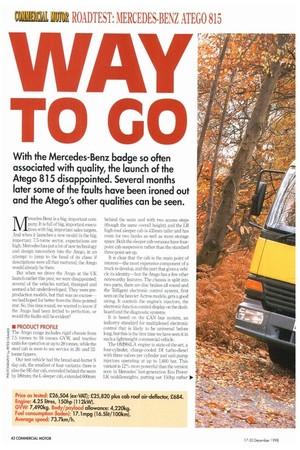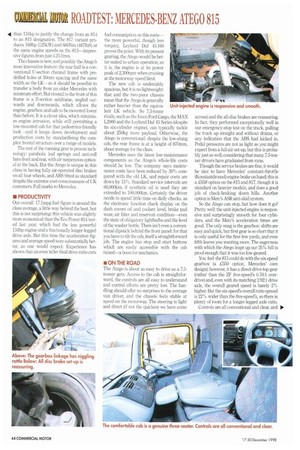1111IW
Page 44

Page 46

Page 48

If you've noticed an error in this article please click here to report it so we can fix it.
TO GO
With the Mercedes-Benz badge so often associated with quality, the launch of the Atego 815 disappointed. Several months later some of the faults have been ironed out and the Atego's other qualities can be seen.
ercedes-I3enz is a big, important company. It is full of big, important execu A. fives with big, important sales targets. And when it launches a new model in the big, important 7.5-tonne sector, expectations are high. Mercedes has put a lot of new technology and design innovation into the Atego, in an attempt to jump to the head of its class: if descriptions were all that mattered, the Atego would already be there.
But when we drove the Atego at the UK launch earlier this year, we were disappointed: several of the vehicles rattled, thumped and seemed a bit underdeveloped. They were preproduction models, but that was no excuse— we had hoped for better from the three-pointed star. So, this time round, we wanted to know if the Atego had been fettled to perfection, or would the faults still be evident?
• PRODUCT PROFILE The Atego range includes rigid chassis from 7.5 tonne..s to 18 tonnes GVW, and tractive units for operation at up to 28 tonnes, while the k steel cab is soon to see service in 26and 32tonne tippers.
Our test vehicle had the bread-and-butter S 6 day cab, the smallest of four variants: there is also the SE day cab, extended behind the seats E by 180nun; the L sleeper cab, extended 600mm
behind the seats and with two access steps (though the same overall height); and the LR high-roof sleeper cab is 435mm taller and has room for two bunks as well as more storage space. Both the sleeper cab versions have fourpoint cab suspension rather than the standard three-point set-up.
It is clear that the cab is the main point of interest—the most expensive component of a truck to develop, and the part that gives a vehicle its identity—but the Atego has a few other noteworthy features. The chassis is split into two parts, there are disc brakes all round and the Telligent electronic control system, first seen on the heavier Actros models, gets a good airing. It controls the engine's injectors, the electronic function control display on the dashboard and the diagnostic systems.
It is based on the CAN bus system, an industry standard for multiplexed electronic control that is likely to be universal before long, but this is the first time we have seen it in such a lightweight commercial vehicle.
The 0M904LA engine is state-of-the-art, a four-cylinder, charge-cooled DI turbo-diesel with three valves per cylinder and unit-pump injectors operating at up to 1,600 bar. This variant is 12% more powerful than the version seen in Mercedes' last-generation Eco Power LK middleweights, putting out 150hp rather P.
than 134hp to justify the change from an 814 to an 815 designation. The 817 variant produces 168hp (125kW) and 660Nm (4871bft) at the same engine speeds as the 815—impressive figures from just 4.25 litres.
The chassis is new, and possibly the Atego's most innovative feature: the rear half is a conventional U-section channel frame with predrilled holes at 50mm spacing and the same width as the LK—so it should be possible to transfer a body from an older Mercedes with minimum effort. But riveted to the front of this frame is a Z-section subframe, angled outwards and downwards, which allows the engine, gearbox and cab to be mounted lower than before. It is a clever idea, which minimises engine intrusion, while still permitting a low-mounted cab for that pedestrian-friendly look—and it keeps down development and production costs by standardising the complex frontal structure over a range of models.
The rest of the running gear is proven technology: parabolic leaf springs and anti-roll bars front and rear, with air suspension optional at the back. But the Atego is unique in this class in having fully air-operated disc brakes on all four wheels, and ABS fitted as standard despite the extreme cost-consciousness of UK customers. Full marks to Mercedes.
• PRODUCTIVITY
Our overall 17.1mpg fuel figure is around the class average, a little way behind the best, but this is not surprising: this vehicle was slightly more economical than the Eco Power 814 tested last year which had the less powerful 134hp engine and a fractionally longer-legged drive axle. But this time the acceleration figures and average speed were substantially better, as one would expect. Experience has shown that an even taller final drive ratio cuts fuel consumption on this mute— the more powerful, though less torquey, Leyland Daf 45160 proves the point. With its present gearing, the Atego would be better suited to urban operation; as it is, the engine is at its power peak of 2,300rpm when cruising at the motorway speed limit.
The new cab is undeniably spacious, but it is no lightweight: that and the two-piece chassis mean that the Atego is generally rather heavier than the equivalent LK vehicle. So 7.5-tonne rivals, such as the lveco Ford Cargo, the MAN L2000 and the Leyland Daf 45 Series (despite its six-cylinder engine), can typically tackle about 250kg more payload. Otherwise, the Atego is conventional: despite the low-slung cab, the rear frame is at a height of 870mm, about average for the class.
Mercedes uses the latest low-maintenance components so the Atego's whole-life costs should be low. The company says maintenance costs have been reduced by 30% compared with the old LK, and repair costs are clown by 15%. Standard service intervals are 60,000km; if synthetic oil is used they are extended to 100,000km. Certainly the driver needs to spend little time on daily checks, as the electronic function check display on the dash covers oil and coolant level, brake pad wear, air filter and reservoir condition—even the state of obligatory lightbulbs and the level of the washer bottle. There isn't even a conventional dipstick behind the front panel: for that you have to tilt the cab, itself a straightforward job. The engine has stop and start buttons which are easily accessible with the cab raised—a boon for mechanics.
• ON THE ROAD
The Atego is about as easy to drive as a 7.5tonner gets. Access to the cab is straightforward, the controls are all easy to understand and control efforts are pretty low. The handling should offer no surprises to the average van driver, and the chassis feels stable at speed on the motorway. The steering is light and direct (if not the quickest we have come across) and the all-disc brakes are reassuring In fact, they performed exceptionally well in our emergency-stop test on the track, pulling the truck up straight and without drama, or any indication that the ABS had kicked in. Pedal pressures are not as light as you might expect from a full-air set-up, but this is probably just as well, considering that many 7.5-tonner drivers have graduated from vans.
Though the service brakes are fine, it would be nice to have Mercedes' constant-throttle (Konstantdrossel) engine brake on hand; this is a £658 option on the 815 and 817, though it is standard on heavier models, and does a good job of check-braking down hills. Another option is Merc's ASR anti-skid system.
So the Atego can stop, but how does it go? Pretty well: the unit-injected engine is responsive and surprisingly smooth for four cylinders, and the Merc's acceleration times are good The only snag is the gearbox: shifts are easy and quick, but first gear is so short that it is only useful for the first few yards, and even fifth leaves you wanting more. The eagerness with which the Atego leapt up our 25% hill is proof enough that it was too low-geared.
You feel the 815 mid do with the six-speed gearbox (a £550 option, Mercedes' own design): however, it has a direct-drive top gear (rather than the ZF five-speed's (176:1 overdrive) and, even with its matching 2.92:1 drive axle, the overall geared speed is barely 2% higher. But the six-speed's overall ratio spread is 22% wider than the five-speed's, so there is plenty of room for a longer-legged axle ratio.
Controls are all conventional and clear, and 10. thankfully Mercedes has dropped the ()Id LK's enormous single control stalk in favour of a pair of stalks. Displays such as the rev-counter and tachograph are well placed, and cruise control is another desirable option. The tachograph is a conventional mode), rather than the top-loading type found in some M-Bs; the fuses, too, are conventional rather than the Actros' miniature electronic circuit breakers.
Even in this steel-sprung base model, the Atego's ride quality is very good and, combined with the excellent visibility from the deep screen and the sizeable mirrors, there is little for a driver to complain about.
• CAB COMFORT Though there is only one step up to the cab (and it is not as low-slung as the sleeper-cab variants), access is easy. The driver's seat is adjustable, as is the steering column and the gear lever is well positioned. So, too, is the handbrake, which is in the usual place, not concealed beside the windscreen pillar as it was in the old LK.
The cab's flat floor means that it is a genuine three-seater, and there is sensible stowage space, even in this spartan day cab. There are bottle holders in the doors and on the back wall, and pop-out cup-holders on the dash. The only disappointment is the ashtray; it is of normal size, rather than monster in the Actros.
The Atego's sound insulation seems exceptionally good-it is quite possible to converse at normal speaking levels on A-roads, and at rest little outside noise comes through-but, oddly, the measured noise levels do not bear this out. The low gearing does not help (there is noticeable turbo whine at high engine speeds) and there is some wind noise from the mirrors, but worst of all is an irritating chatter from the gearshift. Somewhere in the rod-operated linkage a circlip rattles against a bush; you can stop the noise by holding the gear lever, but why should you? It might be a symptom of the conversion to right-hand drive. Overall, though, the 815 seemed rather more solid than the pre-production examples we drove earlier in the year. • SUMMARY The Atego is very good in several ways, but it is not quite the Great Leap Forward we had been hoping for: on-the-road productivity is quite ordinary, but its whole-life running costs and practical uptime could be class-leading.
Perhaps our great expectations were unfair: after all, how different can a 7.5-tonner be? And it will sell well, after all-the purchase price is good, and the three-pointed star bodes well for residual values and customer image. The specification is sensible, the engine is refined and modern, and the Atego is good to drive. The cab is comfortable and well designed, with only a couple of niggling faults. And that is the key: this is a good design that needs a little more development-still, the customer can help, by specifying the right combination of gearbox and final drive ratio.
So Mercedes manages another big, important vehicle launch, if not a totally convincing one. In time, the Atego may well achieve greatness-but not just yet.
L by Toby Clark Price as tested £26,504 (ex-VAT); £25,820 plus cab roof air-deflector, £684. Engine: 4.25 litres, 150hp (112kW). GVVV: 7,490kg. Body/payload allowance: 4,220kg. Fuel consumption (laden): 17.1mpg (16.51it/100km). Average speed: 73.7km/h.












































































































































